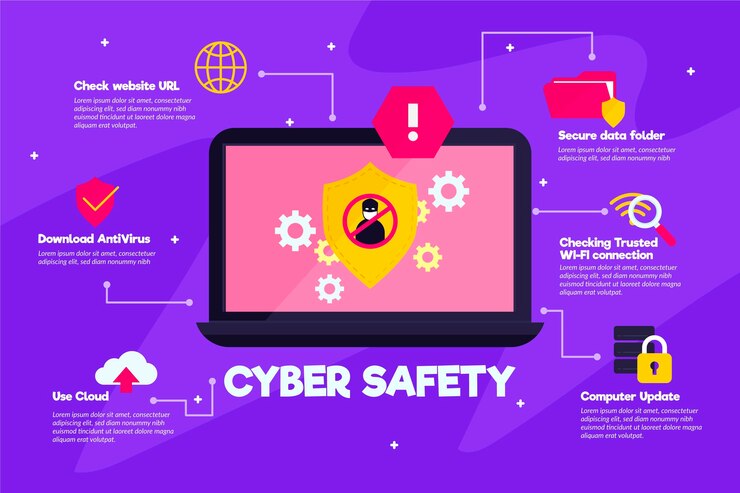Introduction to Cybersecurity
Cybersecurity Tips for Individuals encompasses the measures taken to protect computer systems, networks, and data from unauthorized access or malicious attacks. As technology advances, so do the tactics of cybercriminals, making it essential for individuals to stay informed and proactive in their approach to online security.
Understanding Cyber Threats
Types of Cyber Threats
Cyber threats come in various forms, including malware, phishing attacks, ransomware, and identity theft. Each poses unique risks to personal information and online security.
Common Cyber Attacks
Among the most prevalent cyber attacks are phishing scams, where attackers attempt to trick individuals into revealing sensitive information such as passwords or financial details. Ransomware attacks, on the other hand, involve encrypting data and demanding payment for its release.
Cybersecuirty Tips
1. Strong Passwords and Authentication
Creating strong passwords is a fundamental aspect of cybersecurity. A strong password typically includes a combination of uppercase and lowercase letters, numbers, and special characters. Avoid using easily guessable information like your name, birthdate, or common words. Additionally, enable multi-factor authentication (MFA) whenever possible. MFA adds an extra layer of security by requiring users to provide multiple forms of verification, such as a password and a unique code sent to their mobile device.
2. Software Updates and Patching
Software updates and patching are crucial for addressing known vulnerabilities in operating systems, applications, and software programs. Cybercriminals often exploit these vulnerabilities to gain unauthorized access to devices and networks. By regularly updating software, users can protect themselves against potential exploits and ensure that their systems are equipped with the latest security features.
3. Secure Network Connections
Using secure and encrypted Wi-Fi networks is essential, especially when transmitting sensitive information or conducting online transactions. Public Wi-Fi networks, such as those found in cafes, airports, and hotels, are often targets for cyber attacks. Hackers may intercept data transmitted over these networks, putting users at risk of identity theft and financial fraud. To mitigate these risks, individuals should use virtual private networks (VPNs) or secure Wi-Fi networks with WPA2 encryption.
4. Safe Browsing Habits
Practicing safe browsing habits can help individuals avoid malicious websites and phishing scams. Be cautious of suspicious links sent via email, social media, or instant messaging platforms. These links may lead to fake websites designed to steal login credentials or install malware on the user’s device. Before clicking on a link, verify its authenticity and legitimacy. Additionally, consider using browser extensions or tools that offer real-time protection against phishing attempts and malicious websites.
5. Data Backup and Encryption
Regularly backing up important data is essential for mitigating the impact of data loss due to hardware failure, malware infections, or ransomware attacks. Store backups securely in an encrypted format to prevent unauthorized access. Encryption scrambles data into a format that can only be deciphered with the appropriate decryption key, making it unreadable to unauthorized users. Cloud-based backup solutions and external hard drives are popular options for securely storing encrypted backups.
6. Use of Security Software
Installing reputable antivirus and antimalware software can help detect and remove malicious threats from your devices. These security solutions often include features such as real-time scanning, malware removal, and firewall protection. Regularly update security software to ensure it remains effective against emerging threats and malware variants. Consider investing in comprehensive security suites that offer multiple layers of protection for enhanced cybersecurity.
Cybersecurity Tips for Individuals
- Strong Passwords and Authentication: Use complex passwords and enable multi-factor authentication whenever possible to add an extra layer of security.
- Software Updates and Patching: Regularly update software and applications to address known vulnerabilities and protect against potential exploits.
- Secure Network Connections: Use secure and encrypted Wi-Fi networks, especially when accessing sensitive information or making online transactions.
- Safe Browsing Habits: Be cautious of suspicious links and websites, and only download files from trusted sources.
- Data Backup and Encryption: Back up important data regularly and encrypt sensitive files to prevent unauthorized access.
- Use of Security Software: Install reputable antivirus and antimalware software to detect and remove malicious threats.
- Importance of Regular Security Checks: Routinely scan devices for viruses and malware to ensure they are free from potential threats.
- Educating Yourself and Others: Stay informed about the latest cybersecurity trends and educate family members and colleagues about best practices.
Conclusion
In conclusion, prioritizing cybersecurity is essential for individuals in today’s digital age. By implementing the tips outlined in this article and staying vigilant against emerging threats, individuals can better protect themselves and their personal information online.
FAQs
- What is the importance of cybersecurity for individuals? Cybersecurity helps individuals safeguard their personal information, financial assets, and online identities from potential threats and attacks.
- How can strong passwords enhance cybersecurity? Strong passwords make it more difficult for attackers to gain unauthorized access to accounts and sensitive information, enhancing overall cybersecurity.
- Why is regular software updating crucial for cybersecurity? Regular software updates patch security vulnerabilities and protect against known exploits, reducing the risk of cyber attacks and data breaches.
- What are some signs of a phishing attempt? Signs of a phishing attempt include unsolicited emails requesting sensitive information, suspicious links, and urgent language urging immediate action.
- How can individuals create a robust response plan for cyber threats? Individuals can create a response plan by outlining steps to take in the event of a cyber attack, such as contacting financial institutions, reporting incidents to authorities, and updating security measures.


